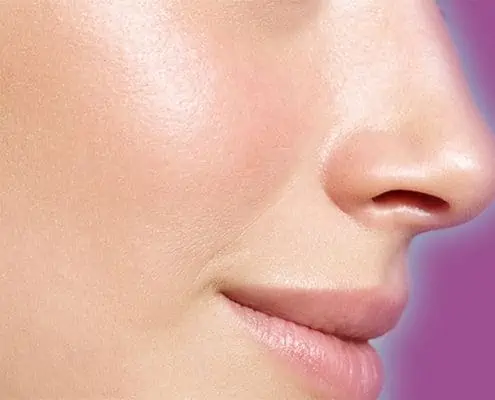
OC 949-428-4500
LA 310-460-2444
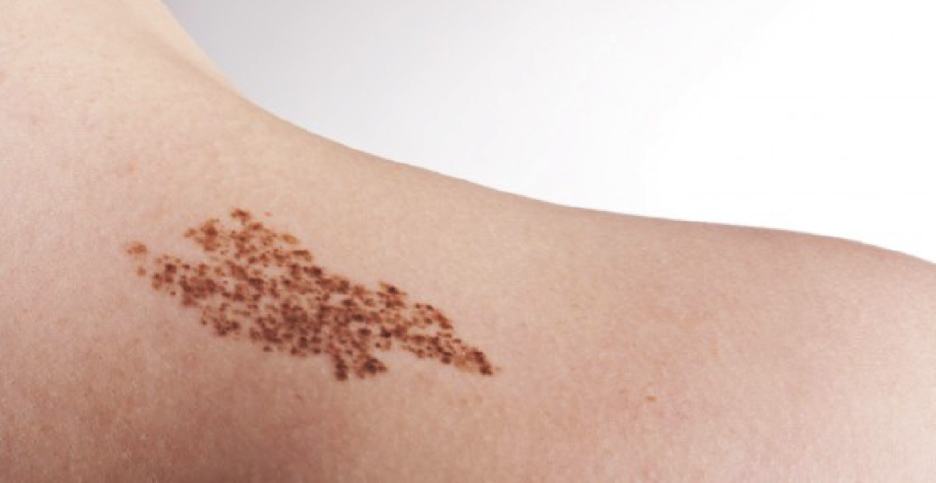
A birthmark is a blemish on the skin visible at birth, or a very short while after birth. Birthmarks can be classified in many ways, according to their appearance.
The two main types of birthmarks are:
As explained above, we’re still not sure why birthmarks emerge and why some babies are born with them, while others are born without them. While most agree they’re not hereditary, one cause of specific types of birthmarks might be the production of proteins by the placenta. It’s been noted that birthmarks are far less common in populations of Asian origins or descent.
Even though it is unknown why most birthmarks occur, scientists have been able to figure out how birthmarks occur: birthmarks can occur as either a pigmented birthmark or a vascular birthmark.
Despite the various appearances that birthmarks may present, a great majority of birthmarks are painless and harmless, and are only a cause for cosmetic concern. However, if you have a birthmark that rapidly changes in appearance, you should get your birthmark checked by a doctor right away, just to be safe.
Based on their shape and color, the different types of birthmarks can be further categorized as follows: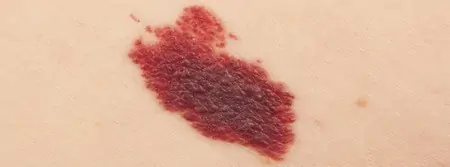
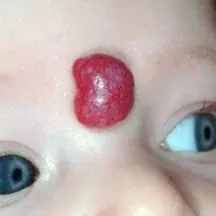
One type of Hemangioma is the strawberry mark. Hemangiomas most often appear within the first few weeks of life and naturally disappear by the age of 10.
These birthmarks are usually red and elevated, even though they’re small and flat in the beginning. They can appear anywhere on the body, but most commonly develop on the scalp, face, chest, and back. There’s no way to know beforehand if the mark will grow, but, if it does, it’s usually within a child’s first 4-5 months of life. Larger Hemanginomas might actually stretch and can even deform the skin.Also know as “Salmon Patches”, “Stork Bites”, “Angel Kisses”, and “Macular Stains”. They are usually thin and flat, with a light pink or red hue and most often appear on the back of the neck, the forehead, the upper lip, the upper eyelids, and between the eyebrows.
Salmon patches on the face are usually called “Angel Kisses” and tend to fade away in a few years—though they might become visible again, when the child cries.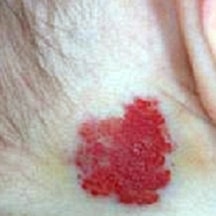

Port-Wine Stains appear when there is an abnormal dilation of capillaries close to the skin that become tangled and cause a deep red or purple discoloration of the skin to appear. Although the actual cause of port-wine stains hasn’t been proven, it has been theorized that the nerve supply to the affected area has been damaged or is faulty. Port-Wine Stains rarely disappear naturally.
Port-Wine Stains typically start off pink, but eventually change to a purple or dark red hue (hence the nickname “Port-Wine”). They can occur in various sizes and on any part of the body, but most usually on the face and are generally smooth and flat, but can potentially thicken or develop small lumps as the person ages.
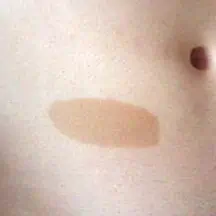
Smooth, round and most likely oval shaped, Cafe-Au-Lait Spots obviously derive their name from their coffee-like color—in fact, they are a milky coffee color, i.e., a light brown.
Cafe-Au-Lait Spots appear right at the time of birth or shortly thereafter and don’t fade away with age. Most babies are born with one or two such birthmarks, but more can occur. They can be found almost anywhere on the body, but are most commonly found on the upper body, legs, and buttocksThis type of birthmark is present on approximately 1% of U.S. babies and 15% of them have these marks on their neck and head. People with fairer skin have these birthmarks in a light brown hue, while darker-skinned individual display them in very dark brown, almost black.
Unlike most other types of birthmarks, these may cause some concern, because they can be lumpy and raised (although they can also be flat). In short, they look like bigger, darker moles. However, they don’t typically increase in size with age, so as the baby grows older, they’ll outgrow them.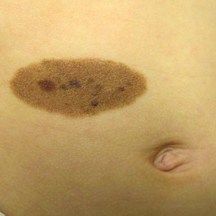
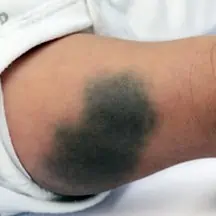
Mongolian Spots affect people with darker skin and come in a blue-grey color similar to that of a bruise. They usually fade away by a child’s fourth birthday. They are most prevalent amongst people of an East Asian, Turkish, East African, or Native American descent.
Mongolian Spots are flat with an irregular shape and wavy borders. They can occur as one large patch or multiple, smaller spots anywhere on the body, but most usually usually appear on the buttocks or the lower back.Doctors don’t usually recommend removing birthmarks, as many of them are harmless and a large portion of them also tend to fade away or disappear on their own. Furthermore, not all birthmarks can be removed, and some treatments may be costly and/or painful.
However, if the patient feels strongly about removing a birthmark, as it causes him/her distress, or if it interferes with a basic life function (feeding, hearing, seeing, breathing), then it should be removed.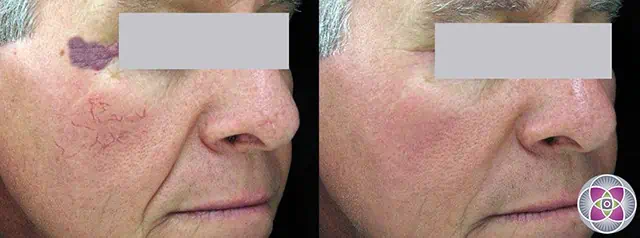
Though many purported skin care companies try to market birthmark removal creams, these rarely work. At best, it will help fade the birthmark away—but since many tend to go away on their own, it’s difficult to tell if the success of such a treatment is real. As an alternative, and to avoid spending your hard earned money on snake oil, we recommend natural and at-home alternatives instead:
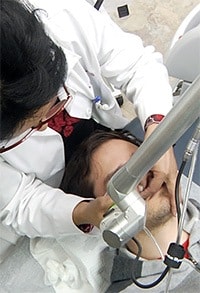
In most cases, a hemangioma will disappear on its own before your child turns 2. However, they may also last for a longer span of time and, by and large, if they haven’t disappeared until the age of 5, they may last until your kid is around 12. To get rid of a pesky hemangioma, you can consider the following treatment options:
Some such birthmarks may even appear on a child’s airways—and they will need to be removed with the aid of an endoscope. The procedure is called bronchoscopy and microlaryngoscopy. In rare cases of an airway hemangioma, some kids will also undergo a temporary tracheostomy, i.e., an opening in their airways, to help them breathe better.
Large, painful, and complex cases of hemanginoma can also be treated with medication, such as oral, liquid propranolol. This substance, which is a beta-blocker will cause the birthmark to shrink in time. Bear in mind that the full scope of the side effects caused by propranolol are still being researched by the medical community.
If this treatment does not work, your child might also have to undergo treatment with steroids or a medication called vincristine.These birthmarks are permanent and do not go away on their own. If concealing them with makeup is not a viable alternative, you will need to undergo laser birthmark removal. This treatment, in general, works better in young children than in adults (whose port wine stains may become enlarged, raised, and lumpy).
The treatment is called pulsed dye laser treatment and sends light 1mm into the skin, through a pen equipped with a fiber optic cable. The light heats up a blood vessel, which then breaks and bruises—but only for a week or two at most. The treatment entails 3-30 sessions spaced at about 6 to 8 weeks apart. It may cause bruising, pain and a sensitivity to natural sunlight which can last for as long as 6 months after the treatment has ended.Doctors Alice Pien, MD and Asher Milgrom, Phd are established pioneers in the fields of Regenerative Medicine and Skincare. Their expertise ranges from advanced laser systems to HCT/P – Stem Cell medicine. Their medical education and advanced certifications span from medical schools of NY State University, the University of Chicago, to Johns Hopkins, Harvard and UCLA. They approach medicine with the clinical expertise of over 85,000 successful treatments over the past 20 years and significant scientific research resulting in proprietary protocols that they customize for each individual patient.
AMA Regenerative Medicine & Skincare | 1570 Brookhollow Dr., Santa Ana, CA 92705 | 6310 San Vicente Blvd STE 285, Los Angeles, CA, 90048 | Privacy Policy